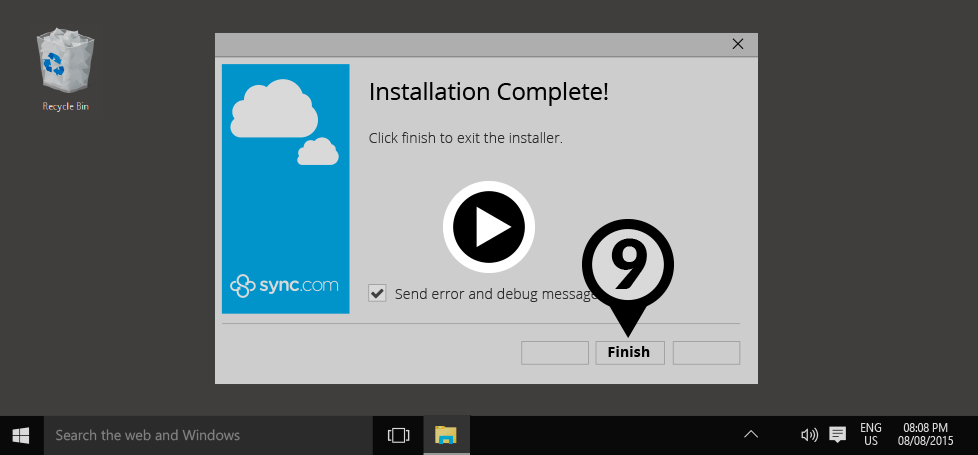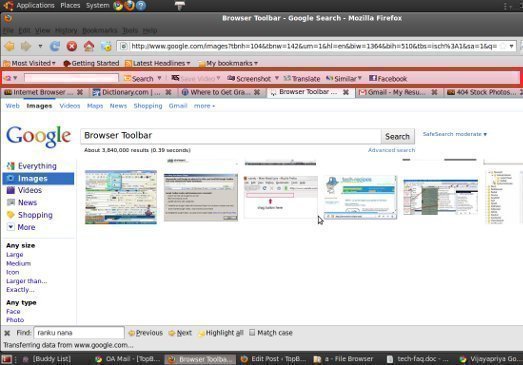- Apple Mac like toolbar on desktop. When I first started using my Dell studio 17 laptop with Windows Vista Home Premium, a 'toolbar' (like on the Apple) appreared at the top of screen with all GUIs or icons on it by category. When cursor went into that area it appeared. That has stopped working.
- In case you’re wondering, minimizing Windows to the dock is not reliable on this one either but it works sometimes at least. To wrap up, if you wanted to replace the taskbar entirely, you can depend on the Nexus dock. Winstep Nexus is one of the best Mac OS docks for Windows 10 out there. Winstep Nexus download.
Classic Shell™ is free software that improves your productivity, enhances the usability of Windows and empowers you to use the computer the way you like it. The main features are: Highly customizable start menu with multiple styles and skins. Quick access to recent, frequently-used, or pinned programs. Find programs, settings, files.
Toolbars
Download Mac Toolbar For Windows 8
A toolbar provides convenient access to frequently used commands and features, and resides in the frame at the top of a window, either below or integrated with the title bar. In Pages, for example, the toolbar includes the commands people use most often as they view, create, and collaborate on documents.
For developer guidance, see NSToolbar.
Toolbar Items
The elements within a toolbar are called toolbar items and consist of either image buttons or specific system controls that are optimized for use in the toolbar.
System controls
Provide toolbar items for the things people do most often. The purpose of the toolbar is to provide shortcuts to common tasks within the app or current window.

Include image buttons or system controls, but not both. Toolbars look best and are easiest to understand when they contain elements of the same type.
Use only toolbar-specific system control styles. In apps that run in macOS 10.15 and earlier, use only the following system control styles in the toolbar. Because these controls are designed to closely integrate with the toolbar’s appearance, they don’t belong in the main content area of a window.
| Control | Style | Control API | Style API |
|---|---|---|---|
| Push button | Textured and rounded | NSButton | NSTexturedRoundedBezelStyle |
| Segmented control | Textured and rounded | NSSegmentedControl | NSSegmentStyleTexturedRounded |
| Segmented control | Separated | NSSegmentedControl | NSSegmentStyleSeparated |
| Pop-up button | Textured and rounded | NSPopUpButton with pullsDown set to false | NSTexturedRoundedBezelStyle |
| Pull-down button | Textured and rounded | NSPopUpButton with pullsDown set to true | NSTexturedRoundedBezelStyle |
| Search field | N/A | NSSearchField | N/A |
Make every toolbar item available as a menu command. Since the toolbar is customizable and can be hidden, it shouldn’t be the only place to find a command. Conversely, it doesn’t make sense to provide toolbar items for every menu item because not all menu commands are important enough or used often enough to warrant inclusion.
Provide a short, descriptive label for every toolbar item. Users see these labels when they configure the toolbar to show icons and text, or text only. Write labels that consist of one or two words that describe the result of clicking the item. Use title-style capitalization, no ending punctuation, and prefer verbs and verb phrases like View, Insert, and Share.
For developer guidance, see NSToolbarItem.
Appearance
Make sure the meaning of each toolbar item is clear. People shouldn’t need to experiment or wait for a tooltip to figure out what an item does. Provide a simple, recognizable glyph and a short, descriptive label.
Prefer system-provided glyphs in toolbar items because they’re familiar. System glyphs automatically receive appropriate coloring and react to user interactions and vibrancy. See System Icons.
Prefer glyphs over text in toolbar items. In a customizable toolbar, labels appear beneath toolbar items when the user chooses to display them, so displaying control text above label text is redundant. If you create custom glyphs, use a maximum size of 19x19 pt (38x38px @2x).
If you need a full-color freestanding toolbar icon, don’t redesign a toolbar version of a well-known interface element. If you use a recognizable icon from elsewhere, don’t change its appearance or perspective. To create full-color freestanding toolbar icons, use the PNG format and provide @1x and @2x icons that measure 32x32 pt (64x64 px @2x).
If you must display text within a control, make sure it’s clear and concise. When describing an object, setting, or state, use a noun or noun phrase. When describing an action, use a verb or verb phrase. In all cases, use title-style capitalization.

Accurately reflect the current state of a control that toggles between two states. Sometimes, a toolbar item toggles an app state on and off. This type of item must clearly communicate its state to the user. You can accomplish this by changing the item’s color scheme and label. For example, Mail includes a toolbar item that toggles accounts online and offline. When an account is online, the item displays a blue icon and a Go Offline label; when it’s offline, the item displays a gray icon and a Go Online label.
Consider using translucency when content flows beneath a toolbar. Translucency creates a sense of depth and context. A toolbar automatically adopts translucency when placed above a scroll view or when the window is configured as a full-size content view. For developer guidance, see NSFullSizeContentViewWindowMask. For related design guidance, see Translucency.

Avoid giving a toolbar item a persistent selected appearance. Clicking a toolbar item results in an immediate action — such as opening a new window, switching to a different view, displaying a menu, or inserting (or removing) an object — so it doesn’t make sense to imply that there is also a change in state. The exception to this is a segmented control that shows a persistent selected appearance within the context of the control, such as the view controls in a Finder window toolbar.
Microsoft Windows 7 Toolbar Download
Layout
Arrange toolbar items to support the main task people accomplish in your app. In general, use the leading end of the toolbar for commands that should have the highest visibility. “High visibility” can mean different things in different apps. In some apps, frequency of use should determine visibility. In other apps, it makes more sense to rank items by importance.
If appropriate, group related toolbar items. In some cases, you can define logical groups of toolbar items, such as one group for document manipulation tasks and another for text manipulation tasks. When you create a group, arrange its items according to importance or frequency of use. Use the same criteria to arrange groups themselves. The toolbar in Keynote includes several groups that are based on functionality, including one for presentation-level functions, one for playback functions, and one for object insertion.
Visibility
Let people show or hide the toolbar. A user might want to hide the toolbar to minimize distractions or reveal more content. Be sure to provide commands for hiding and revealing the toolbar in the View menu.
Consider automatically hiding the toolbar in full-screen mode to increase the focus on content. Although people usually rely on the presence of a toolbar, you can hide it in a full-screen window if it’s not needed to accomplish the focused task. For example, Preview hides the toolbar in a full-screen window because people are more likely to view content than to annotate it. If you hide the toolbar in a full-screen window, reveal it (along with the menu bar) when the pointer moves to the top of the screen.
Customization
Toolbars are often customizable. In a customizable toolbar, people can decide which items appear in the toolbar, and in many cases choose whether to show the items as icons, text, or icons and text combined. Some toolbars let the user choose whether large or small toolbar items are displayed. Apps often let people hide the toolbar entirely, for increased focus on content.
In general, let people customize the toolbar. People have different workflows and should ideally be able to customize the toolbar’s contents and appearance to support their individual working styles.
Provide useful default toolbar items. Not everyone customizes the toolbar so your default items should be commands that most people find useful. Ideally, toolbar commands also educate new users about the key features of your app.
If you allow customization, add the Customize Toolbar menu item to the View menu. See View Menu.
Behavior
Don’t add an app-specific contextual menu to the toolbar. A toolbar already has a contextual menu that’s used consistently across the system for customization. Additionally, title bars often let people Control-click to rename a document or reveal its path. If you require a set of commands that act on the selection, either add a contextual menu in the content area of the window, or add an action pop-up button in the toolbar. For related guidance, see Contextual Menus and Action Pop-Up Buttons.
Consider letting people click nondestructive toolbar items when a window is inactive. Usually, clicking the toolbar of an inactive window brings the window to the front. In some cases, it may be useful to let the user invoke a toolbar item without bringing the window to the front so they can stay focused on a task in a different window. The toolbar of the standard Fonts panel behaves this way.
Consider adding spring-loading support to toolbar items. On pressure-sensitive systems, such as systems with the Force Touch trackpad, spring loading lets a user activate a button or segmented control segment by dragging items over it and force clicking — that is, pressing harder — without dropping the items. The user can then continue dragging the items, possibly to perform additional actions. In Calendar, for example, people can drag an event over the day, week, month, or year segments in the toolbar. Force clicking a segment switches the calendar view without releasing the event, so people can drop the event at the desired location in the new calendar view.